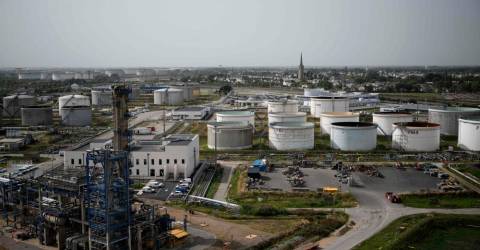Oil prices jump, settle up 3% on strong US economy, Red Sea tensions

Oil prices rose by 3% on Thursday to reach their highest level since December due to faster-than-expected US economic growth in the last quarter and ongoing tensions in the Red Sea. Brent crude settled at $82.43 a barrel and US West Texas Intermediate crude reached $77.36 a barrel. Geopolitical tensions in the Middle East and disruptions to shipping in the Red Sea were cited as causes for the price increase. A draw in US crude inventories and expectations of China's recovering economy also contributed to the rise.
Source: Link
Frequently Asked Questions
FAQ: Oil Prices Jump, Settle Up 3% on Strong US Economy, Red Sea Tensions
1. Why did oil prices jump recently?
Oil prices jumped and settled up by 3% recently due to a combination of a strong US economy and geopolitical tensions in the Middle East, particularly in the Red Sea region.
2. What was the specific increase in US West Texas Intermediate crude?
US West Texas Intermediate crude gained US$2.27, or 3.02%, reaching US$77.36 (RM366.33).
3. What are the factors that affected oil prices apart from the US economy and Red Sea tensions?
The article does not provide additional factors influencing the price rise in that specific instance. However, oil prices are typically influenced by a range of factors including geopolitical tensions, global supply and demand, OPEC policies, natural disasters, and currency fluctuations.
4. What might be the implications of increasing oil prices for the global economy?
Rising oil prices can lead to higher costs for transportation and goods, potentially leading to increased inflation. They can also impact economic growth and the balance of trade for countries that are net importers of oil.
5. Is the increase in oil prices due to an increase in the US crude supply?
No, the increase in oil prices mentioned in the query is not directly attributed to US crude supply. Previously, on November 8, 2023, a Reuters report indicated that there were signs of higher supply and oil prices fell, reaching a three-month low at that time.
6. How does the US intend to handle CO2 emissions in response to fossil fuel concerns?
The Long-Term Strategy of the United States, as outlined in the provided whitepaper, describes pathways to net-zero emissions by 2050. This includes reducing energy-related CO2 emissions and transitioning to renewable energy sources.
For the most detailed and updated information, readers should refer to the original article on the Sun's website:
https://thesun.my/business/oil-prices-jump-settle-up-3-on-strong-us-economy-red-sea-tensions-CA12030442

